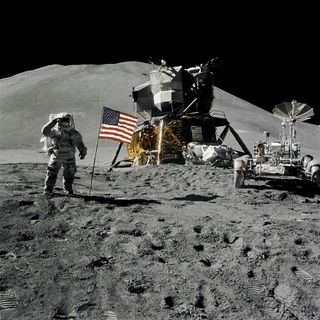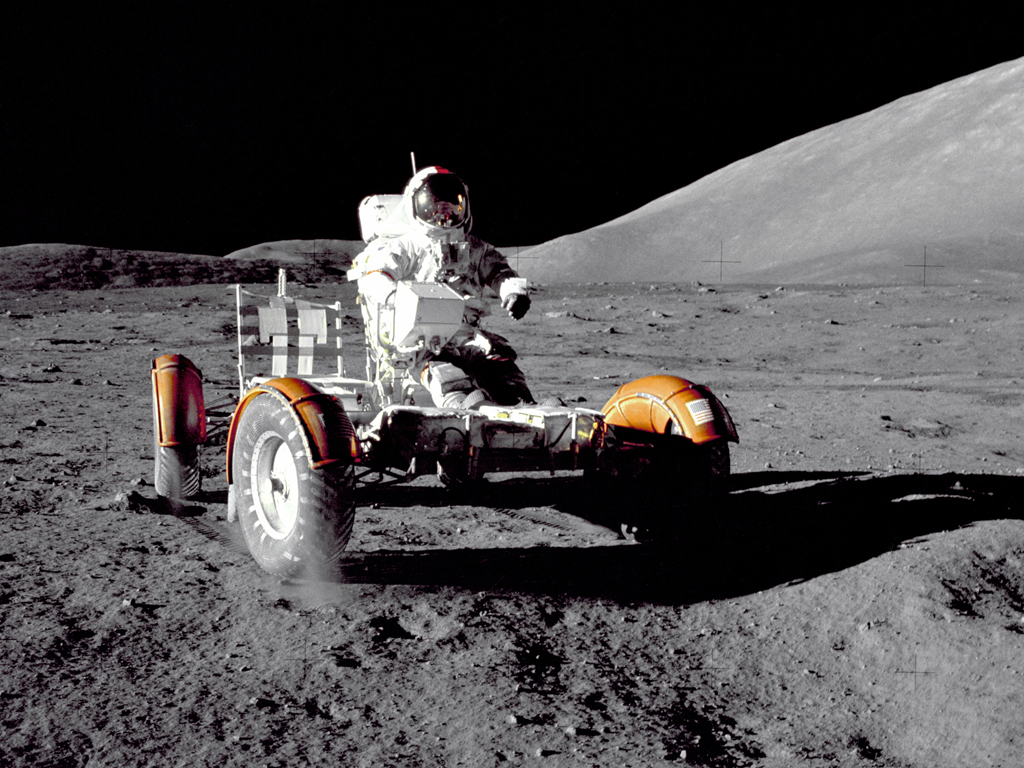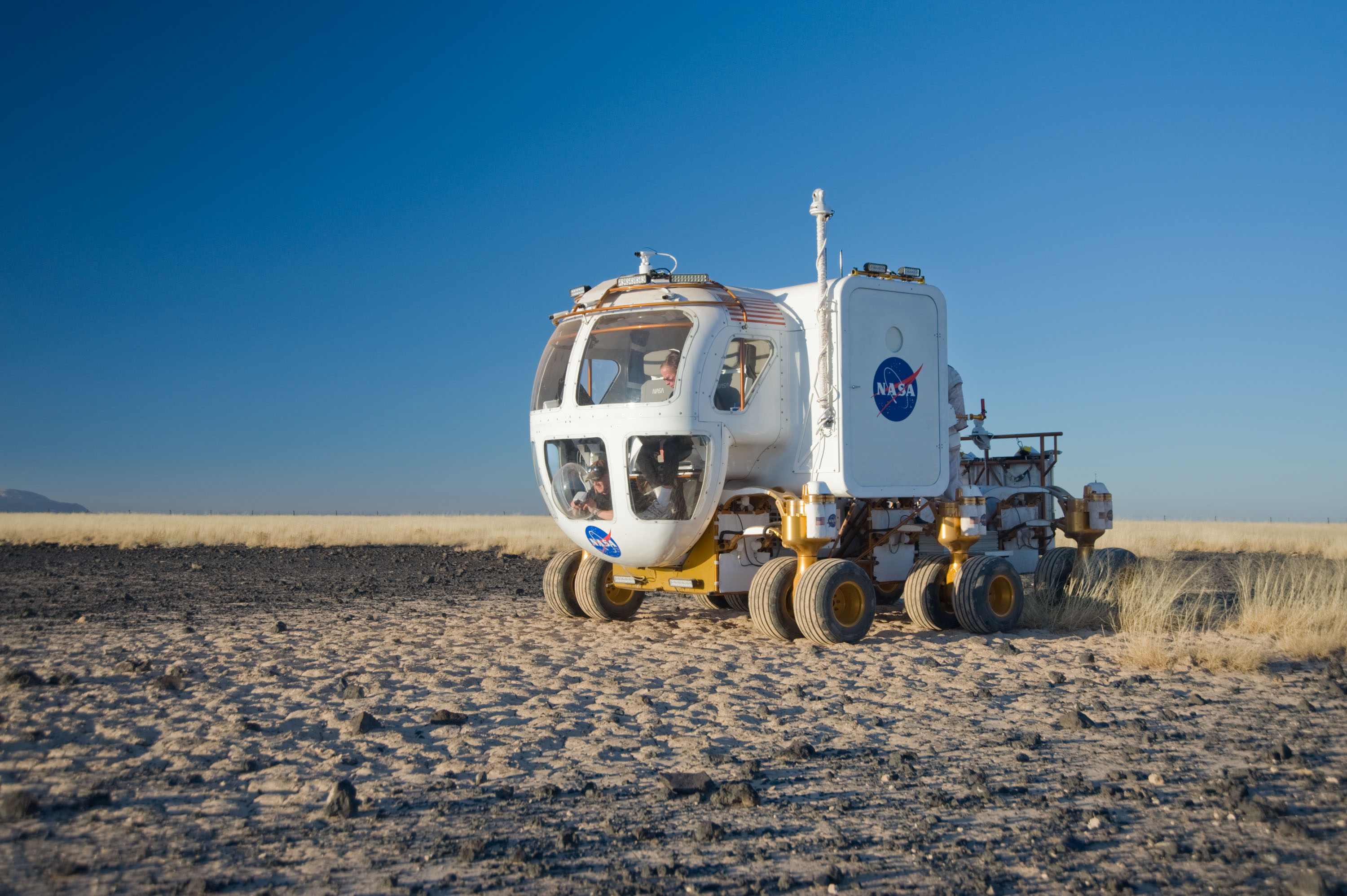if they didnt go to the moon what about the images of the moon rover and lem taken by satelites
Driving on the Moon: The 40-Year Legacy of NASA'southward Offset Lunar Machine

When NASA's Apollo xv astronauts David Scott and James Irwin touched downwardly on the moon 40 years ago, they had an actress special tool packed abroad on their lunar lander: a dune buggy-size rover that enabled them to become the showtime humans to drive on the surface of a globe beyond Earth.
Rover technology has made cracking strides since Scott and Irwin landed on the moon on July xxx, 1971, merely the lessons learned from NASA's beginning Lunar Roving Vehicles (LRVs) are still applicable today. While engineering science has evolved since the Apollo era, NASA'south get-go rovers are influencing manned and robotic vehicles for exploration on Mars and across.
"The LRV on Apollo fulfilled a very of import need, which was to be able to comprehend large traverses, conduct more samples, and get more scientific exploration done," Mike Neufeld, a curator in the space history division at the Smithsonian National Air and Space Museum in Washington, D.C. told Space.com. "It was a actually of import part of why Apollo fifteen, 16 and 17 were so much more scientifically advanced and productive." [Photos: The Evolution of NASA'due south Moon Cars]
Driving on the moon
Apollo fifteen was the quaternary mission to land men on the moon, and it was the first of three missions to use the LRVs. The rover had a mass of most 460 pounds (208 kilograms) and was designed to fold up so it could fit inside a compartment of the Lunar Module.

"It was a very elegant little vehicle," Neufeld said. "It had to be lightweight and had to be folded up in a very compact space. They were very successful – at that place were no major failures – so clearly information technology was a successful design." [Video: NASA'southward 21st Century Moon Ride]
And they drove relatively well, Neufeld said, given the rocky terrain on the moon. The rovers could reach a top speed of about eight mph (about 13 kph), merely the moon's cratered surface prevented the astronauts from driving as well fast.
"They weren't driving on apartment land – information technology was more like a dirt buggy than anything else," he explained. "It didn't travel that fast, but for the astronauts who drove it, it seemed like information technology was exciting and fast. It was a pretty bouncy ride. Even flat looking terrain on the moon is not very apartment because in that location are so many crater pits, then it would take been a adequately exciting ride."
The lunar rovers besides injected a new level of public enthusiasm for the Apollo programme.
"Overall public interest had declined after Apollo 11," Neufeld said. "The public was condign more than and more blasé. Apollo xv provided a blip upwards in public interest. Function of information technology was because the landing site was so much more attractive, and in that location were besides more television set broadcasts from the moon. But, the rovers were definitely a role of that. The public took a lot of interest in this new adequacy that the astronauts had."
The LRVs allowed the Apollo astronauts to explore beyond their landing site, but at that place were definite limitations, such as the not-rechargeable bombardment life of the rovers. As a condom precaution, the vehicles were also constrained to a altitude that, if the rover broke down, the astronauts would take enough resource in their life support systems to walk dorsum to the Lunar Module.
On the Apollo 15 mission, the LRV was driven a full of virtually 17 miles (27 km), which amounted to 3 hours and 2 minutes of driving time, co-ordinate to NASA officials.

Moon rover legacy
In the decades since the end of the Apollo program, engineers have looked to the LRVs for cues on how to develop current and future manned and robotic rovers. [Coolest Vehicles Y'all'll Never Go to Ride]
At NASA's Jet Propulsion Laboratory (JPL) in Pasadena, Calif., engineers collaborated with Apollo-era designers to develop the vehicles for the Mars Pathfinder project. Even though past and current Mars rovers were designed to exist robotic, studying the first manned lunar vehicles proved invaluable, said Kobie Boykins, an engineer in JPL's spacecraft mechanical and applied science partition.
"In that location was a lot of information that we learned," Boykins told Infinite.com. "We watched videos and saw how the NASA astronauts drove effectually on the rover. All the basic physics of how we interact with the soil stays the same even without having a human being in the rover. It helped usa empathize our capabilities and our limits. We needed to then figure out how to drive over rocks and drive on steeper inclines, but information technology's all applicable."
Boykins and his team worked on the twin Spirit and Opportunity rovers, which landed on Mars in Jan 2004 and have greatly outlasted their planned iii-month lifespan. Spirit, which got stuck in sand, was declared dead by its operators earlier this year, but Opportunity is withal driving steadily on the surface of the Ruddy Planet.
In add-on to being robotic, the Mars rovers differed from the Lunar Roving Vehicles considering they collection at a much slower pace – almost 2 inches per 2d (5cm/s).
"Information technology'southward about the land speed of a Galapagos turtle," Boykins said. "There were a lot of blueprint ideas that came from the Apollo days, but the lunar rovers were orders of magnitude faster."
Future space motorcar tech
Boykins is also working on NASA's newest Mars rover, a car-sized robotic explorer named Curiosity, which is scheduled to launch into infinite in late Nov. Simply NASA teams are too involved in developing other rovers, ones that could eventually exist driven past humans once again on the surface of the moon or Mars.

The Space Exploration Vehicle (SEV) looks like a luxury RV compared to the more primitive-looking lunar rovers, only the Apollo programme definitely put its postage on this adjacent generation vehicle, said Lucien Junkin, an engineer with the SEV project at NASA's Johnson Space Heart.
The SEV engineers worked closely with Harrison Schmitt to blueprint and test the new vehicle, which features an enclosed, pressurized cabin, 12 wheels and mounted spacesuits on the back. Schmitt, a onetime NASA astronaut, drove one of the original lunar rovers during the Apollo 17 mission, the final flight that rounded out the Apollo space program.
"We wanted to take all the lessons learned from the Apollo and Mars rovers and combine all that together, simply also claiming conventional wisdom," Junkin told SPACE.com. "With the SEV, we built what we call a feature-rich vehicle, so things like cargo, space and other creature comforts. We wanted to keep it simple but move it forrad."
The SEV is designed to comfortably carry a two-astronaut coiffure on multiple day excursions. The vehicle was originally designed as role of the at present-canceled Constellation program that was going to return astronauts to the moon. The engineering science squad is at present designing and testing the vehicle to be compatible with futurity missions that could require rovers either on the moon or Mars, Junkin said.
"We take to stay away from the policy and keep our nose to the grindstone," he said. "We desire to keep developing a rover that is in America'southward garage, so when it's time for u.s. to go to some other heavenly body or another planet, America will be ready with a vehicle."
You can follow SPACE.com staff writer Denise Chow on Twitter @denisechow . Follow SPACE.com for the latest in space science and exploration news on Twitter @Spacedotcom and on Facebook .
Join our Space Forums to go on talking infinite on the latest missions, night heaven and more! And if you have a news tip, correction or comment, permit us know at: community@space.com.
Source: https://www.space.com/12482-moon-car-lunar-rover-apollo-15-legacy.html

Postar um comentário for "if they didnt go to the moon what about the images of the moon rover and lem taken by satelites"